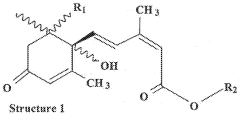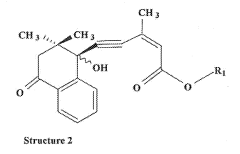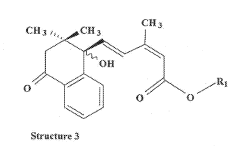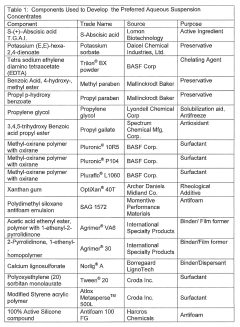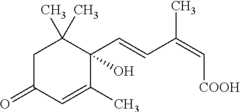How Abscisic Acid Influences Resource Allocation in Crops?
JUL 14, 20259 MIN READ
Generate Your Research Report Instantly with AI Agent
Patsnap Eureka helps you evaluate technical feasibility & market potential.
ABA and Crop Resource Allocation: Background and Objectives
Abscisic acid (ABA) is a crucial plant hormone that plays a pivotal role in regulating various physiological processes, including resource allocation in crops. The study of ABA's influence on resource distribution has gained significant attention in recent years due to its potential to enhance crop productivity and resilience in the face of environmental stresses.
The primary objective of this technical research report is to comprehensively examine how ABA influences resource allocation in crops, with a focus on understanding the underlying mechanisms and potential applications in agriculture. This investigation aims to provide valuable insights into the complex interplay between ABA signaling and the distribution of essential resources such as water, nutrients, and photosynthetic products within crop plants.
The evolution of ABA research can be traced back to the 1960s when it was first identified as a plant growth inhibitor. Since then, our understanding of ABA's functions has expanded dramatically, revealing its multifaceted roles in plant development, stress responses, and resource management. The current technological landscape surrounding ABA research encompasses a wide range of tools and methodologies, including advanced molecular biology techniques, high-throughput phenotyping platforms, and sophisticated imaging technologies.
Recent advancements in genomics and metabolomics have further accelerated our ability to decipher the intricate signaling networks associated with ABA-mediated resource allocation. These technological breakthroughs have opened up new avenues for exploring the potential of ABA in crop improvement strategies, particularly in the context of climate change and food security challenges.
The significance of this research lies in its potential to address critical agricultural issues, such as improving water use efficiency, enhancing nutrient uptake and utilization, and optimizing biomass allocation for increased yield. By elucidating the mechanisms through which ABA influences resource distribution, we can develop novel approaches to fine-tune crop responses to environmental cues and maximize resource utilization efficiency.
This technical research report aims to bridge the gap between fundamental ABA biology and practical applications in crop science. By synthesizing current knowledge and identifying key research directions, we seek to provide a comprehensive framework for understanding and manipulating ABA-mediated resource allocation in crops. The insights gained from this investigation will not only contribute to our scientific understanding of plant physiology but also inform the development of innovative strategies for sustainable agriculture and food production in the face of global environmental challenges.
The primary objective of this technical research report is to comprehensively examine how ABA influences resource allocation in crops, with a focus on understanding the underlying mechanisms and potential applications in agriculture. This investigation aims to provide valuable insights into the complex interplay between ABA signaling and the distribution of essential resources such as water, nutrients, and photosynthetic products within crop plants.
The evolution of ABA research can be traced back to the 1960s when it was first identified as a plant growth inhibitor. Since then, our understanding of ABA's functions has expanded dramatically, revealing its multifaceted roles in plant development, stress responses, and resource management. The current technological landscape surrounding ABA research encompasses a wide range of tools and methodologies, including advanced molecular biology techniques, high-throughput phenotyping platforms, and sophisticated imaging technologies.
Recent advancements in genomics and metabolomics have further accelerated our ability to decipher the intricate signaling networks associated with ABA-mediated resource allocation. These technological breakthroughs have opened up new avenues for exploring the potential of ABA in crop improvement strategies, particularly in the context of climate change and food security challenges.
The significance of this research lies in its potential to address critical agricultural issues, such as improving water use efficiency, enhancing nutrient uptake and utilization, and optimizing biomass allocation for increased yield. By elucidating the mechanisms through which ABA influences resource distribution, we can develop novel approaches to fine-tune crop responses to environmental cues and maximize resource utilization efficiency.
This technical research report aims to bridge the gap between fundamental ABA biology and practical applications in crop science. By synthesizing current knowledge and identifying key research directions, we seek to provide a comprehensive framework for understanding and manipulating ABA-mediated resource allocation in crops. The insights gained from this investigation will not only contribute to our scientific understanding of plant physiology but also inform the development of innovative strategies for sustainable agriculture and food production in the face of global environmental challenges.
Market Demand for ABA-based Crop Enhancement
The market demand for ABA-based crop enhancement technologies has been steadily growing in recent years, driven by the increasing need for sustainable agricultural practices and improved crop resilience. As global climate change continues to pose challenges to food security, farmers and agricultural companies are seeking innovative solutions to enhance crop productivity and stress tolerance.
ABA-based technologies offer promising applications in various aspects of crop management, including drought resistance, water use efficiency, and overall plant health. This has led to a surge in interest from both large-scale commercial farms and smallholder farmers looking to optimize their crop yields in the face of unpredictable weather patterns and water scarcity.
The global market for plant growth regulators, including ABA-based products, is projected to experience significant growth in the coming years. This expansion is fueled by the rising adoption of precision agriculture techniques and the increasing awareness of the benefits of plant hormones in crop management. Developing countries, particularly in Asia and Africa, are emerging as key markets for ABA-based technologies as they strive to improve agricultural productivity and food security.
Several factors contribute to the growing market demand for ABA-based crop enhancement solutions. First, the increasing frequency of extreme weather events, such as droughts and heatwaves, has heightened the need for crops that can withstand environmental stresses. ABA's role in regulating plant responses to abiotic stresses makes it a valuable tool in developing more resilient crop varieties.
Second, the push for sustainable agriculture practices has created a favorable environment for ABA-based technologies. As governments and consumers alike demand more environmentally friendly farming methods, products that can improve resource use efficiency, particularly water conservation, are gaining traction in the market.
Third, advancements in biotechnology and genetic engineering have opened up new possibilities for manipulating ABA pathways in crops, leading to the development of novel products and applications. This has attracted significant investment from both established agrochemical companies and innovative startups, further driving market growth.
The market for ABA-based crop enhancement is not limited to direct applications of the hormone itself. It also encompasses a range of related products and services, including genetically modified seeds with enhanced ABA sensitivity, precision agriculture tools for monitoring plant stress levels, and specialized fertilizers designed to work in conjunction with ABA-mediated processes.
As research continues to uncover new insights into ABA's role in resource allocation and stress response in crops, the potential applications and market opportunities are expected to expand further. This presents a promising outlook for companies investing in ABA-related technologies and underscores the importance of continued research and development in this field.
ABA-based technologies offer promising applications in various aspects of crop management, including drought resistance, water use efficiency, and overall plant health. This has led to a surge in interest from both large-scale commercial farms and smallholder farmers looking to optimize their crop yields in the face of unpredictable weather patterns and water scarcity.
The global market for plant growth regulators, including ABA-based products, is projected to experience significant growth in the coming years. This expansion is fueled by the rising adoption of precision agriculture techniques and the increasing awareness of the benefits of plant hormones in crop management. Developing countries, particularly in Asia and Africa, are emerging as key markets for ABA-based technologies as they strive to improve agricultural productivity and food security.
Several factors contribute to the growing market demand for ABA-based crop enhancement solutions. First, the increasing frequency of extreme weather events, such as droughts and heatwaves, has heightened the need for crops that can withstand environmental stresses. ABA's role in regulating plant responses to abiotic stresses makes it a valuable tool in developing more resilient crop varieties.
Second, the push for sustainable agriculture practices has created a favorable environment for ABA-based technologies. As governments and consumers alike demand more environmentally friendly farming methods, products that can improve resource use efficiency, particularly water conservation, are gaining traction in the market.
Third, advancements in biotechnology and genetic engineering have opened up new possibilities for manipulating ABA pathways in crops, leading to the development of novel products and applications. This has attracted significant investment from both established agrochemical companies and innovative startups, further driving market growth.
The market for ABA-based crop enhancement is not limited to direct applications of the hormone itself. It also encompasses a range of related products and services, including genetically modified seeds with enhanced ABA sensitivity, precision agriculture tools for monitoring plant stress levels, and specialized fertilizers designed to work in conjunction with ABA-mediated processes.
As research continues to uncover new insights into ABA's role in resource allocation and stress response in crops, the potential applications and market opportunities are expected to expand further. This presents a promising outlook for companies investing in ABA-related technologies and underscores the importance of continued research and development in this field.
Current Understanding and Challenges in ABA Signaling
Abscisic acid (ABA) signaling plays a crucial role in plant responses to environmental stresses and resource allocation. The current understanding of ABA signaling has advanced significantly in recent years, yet several challenges remain in fully elucidating its mechanisms and applications in crop management.
ABA signaling is initiated by the perception of ABA by the PYR/PYL/RCAR receptor family. Upon binding, these receptors undergo conformational changes that enable them to interact with and inhibit PP2C phosphatases. This inhibition releases SnRK2 protein kinases from negative regulation, allowing them to phosphorylate downstream targets, including transcription factors and ion channels. This cascade ultimately leads to various physiological responses, such as stomatal closure and altered gene expression.
One of the key challenges in ABA signaling research is understanding the specificity and redundancy among the numerous components involved. With multiple ABA receptors, PP2Cs, and SnRK2s identified, determining their individual roles and potential functional overlap remains complex. This complexity is further compounded by the tissue-specific expression patterns and potential cross-talk with other signaling pathways.
Another significant challenge lies in deciphering the temporal and spatial dynamics of ABA signaling. While the core signaling pathway is well-established, the precise mechanisms governing the rapid and localized responses to ABA remain unclear. Advanced imaging techniques and biosensors are being developed to address this issue, but further refinement is needed to capture the full complexity of ABA signaling in planta.
The regulation of ABA biosynthesis and catabolism presents another area of ongoing research. While key enzymes in these processes have been identified, the factors controlling their activity and expression under various environmental conditions are not fully understood. This knowledge gap hinders our ability to manipulate ABA levels precisely for crop improvement.
Translating the molecular understanding of ABA signaling into practical applications for crop management poses a significant challenge. While ABA's role in drought tolerance is well-established, harnessing this knowledge to develop more resilient crops has proven complex. Factors such as the potential trade-offs between stress tolerance and yield, as well as the environmental variability in field conditions, complicate the application of ABA-related strategies in agriculture.
Furthermore, the interaction between ABA signaling and other phytohormone pathways in regulating resource allocation remains an active area of investigation. Unraveling these complex networks is crucial for developing comprehensive strategies to optimize crop performance under various environmental conditions.
ABA signaling is initiated by the perception of ABA by the PYR/PYL/RCAR receptor family. Upon binding, these receptors undergo conformational changes that enable them to interact with and inhibit PP2C phosphatases. This inhibition releases SnRK2 protein kinases from negative regulation, allowing them to phosphorylate downstream targets, including transcription factors and ion channels. This cascade ultimately leads to various physiological responses, such as stomatal closure and altered gene expression.
One of the key challenges in ABA signaling research is understanding the specificity and redundancy among the numerous components involved. With multiple ABA receptors, PP2Cs, and SnRK2s identified, determining their individual roles and potential functional overlap remains complex. This complexity is further compounded by the tissue-specific expression patterns and potential cross-talk with other signaling pathways.
Another significant challenge lies in deciphering the temporal and spatial dynamics of ABA signaling. While the core signaling pathway is well-established, the precise mechanisms governing the rapid and localized responses to ABA remain unclear. Advanced imaging techniques and biosensors are being developed to address this issue, but further refinement is needed to capture the full complexity of ABA signaling in planta.
The regulation of ABA biosynthesis and catabolism presents another area of ongoing research. While key enzymes in these processes have been identified, the factors controlling their activity and expression under various environmental conditions are not fully understood. This knowledge gap hinders our ability to manipulate ABA levels precisely for crop improvement.
Translating the molecular understanding of ABA signaling into practical applications for crop management poses a significant challenge. While ABA's role in drought tolerance is well-established, harnessing this knowledge to develop more resilient crops has proven complex. Factors such as the potential trade-offs between stress tolerance and yield, as well as the environmental variability in field conditions, complicate the application of ABA-related strategies in agriculture.
Furthermore, the interaction between ABA signaling and other phytohormone pathways in regulating resource allocation remains an active area of investigation. Unraveling these complex networks is crucial for developing comprehensive strategies to optimize crop performance under various environmental conditions.
Existing ABA Applications in Crop Management
01 Abscisic acid signaling in plant stress response
Abscisic acid plays a crucial role in plant stress response mechanisms. It regulates various physiological processes, including stomatal closure, seed dormancy, and adaptive responses to environmental stresses such as drought, salinity, and cold. The signaling pathways involved in abscisic acid-mediated stress responses are complex and involve multiple components, including receptors, kinases, and transcription factors.- Abscisic acid signaling in plant stress response: Abscisic acid plays a crucial role in plant stress response mechanisms. It regulates various physiological processes, including stomatal closure, seed dormancy, and adaptive responses to environmental stresses such as drought, salinity, and cold. Understanding the signaling pathways and resource allocation controlled by abscisic acid can help improve crop resilience and productivity under adverse conditions.
- Genetic manipulation of abscisic acid biosynthesis and signaling: Genetic engineering techniques are used to modify abscisic acid biosynthesis and signaling pathways in plants. This approach allows for the development of crops with enhanced stress tolerance and improved resource allocation. By altering genes involved in abscisic acid metabolism or perception, researchers can create plants with optimized responses to environmental stresses and more efficient use of available resources.
- Abscisic acid-mediated resource allocation in crop management: Abscisic acid influences the allocation of resources within plants, affecting processes such as root growth, leaf senescence, and fruit development. Understanding and manipulating these allocation patterns can lead to improved crop management strategies. This includes optimizing irrigation schedules, nutrient application, and harvest timing based on abscisic acid-mediated responses to maximize yield and quality while minimizing resource waste.
- Exogenous application of abscisic acid for crop improvement: The external application of abscisic acid or its synthetic analogs can be used to enhance crop performance and resource use efficiency. This approach allows for targeted manipulation of plant responses to environmental stresses and resource availability. By carefully timing and dosing abscisic acid applications, farmers can potentially improve drought tolerance, fruit quality, and overall crop productivity.
- Abscisic acid's role in seed dormancy and germination: Abscisic acid plays a critical role in regulating seed dormancy and germination, which are important aspects of resource allocation in plant life cycles. By controlling these processes, abscisic acid influences the timing of seedling emergence and early growth, which can significantly impact plant survival and resource utilization. Understanding and manipulating these mechanisms can lead to improved seed technologies and more efficient crop establishment.
02 Genetic engineering for improved abscisic acid production
Genetic modification techniques are employed to enhance abscisic acid production in plants. This involves manipulating genes involved in abscisic acid biosynthesis, catabolism, or signaling pathways. By altering the expression of key genes, researchers aim to improve plant stress tolerance, water use efficiency, and overall crop productivity under adverse environmental conditions.Expand Specific Solutions03 Abscisic acid-based agricultural formulations
Development of agricultural formulations containing abscisic acid or its analogs for external application to crops. These formulations are designed to enhance plant stress tolerance, improve water use efficiency, and regulate growth and development. The effectiveness of such formulations depends on factors like concentration, application method, and timing in relation to plant growth stages and environmental conditions.Expand Specific Solutions04 Abscisic acid resource allocation in plant tissues
Studies on the distribution and allocation of abscisic acid resources within plant tissues. This includes investigating the transport mechanisms of abscisic acid between different plant organs, its accumulation in specific tissues during stress conditions, and the regulation of its biosynthesis and catabolism in various plant parts. Understanding these processes is crucial for developing strategies to optimize plant performance under stress.Expand Specific Solutions05 Computational modeling of abscisic acid-mediated processes
Development of computational models and algorithms to simulate and predict abscisic acid-mediated processes in plants. These models integrate various data sources, including genomic, transcriptomic, and metabolomic information, to provide insights into abscisic acid signaling networks, resource allocation, and plant responses to environmental stresses. Such models can aid in designing more effective strategies for crop improvement and stress management.Expand Specific Solutions
Key Players in ABA-related Crop Science
The competitive landscape for abscisic acid's influence on resource allocation in crops is in an early growth stage, with increasing market potential as agricultural challenges intensify. The global market for plant growth regulators, including abscisic acid, is projected to reach $3.3 billion by 2026. While the technology is still developing, several key players are advancing research and applications. Universities like China Agricultural University and Huazhong Agricultural University are conducting foundational studies, while companies such as Valent BioSciences and Syngenta are developing commercial products. The involvement of both academic institutions and industry leaders indicates growing interest in harnessing abscisic acid's potential to improve crop resilience and productivity in the face of climate change and food security concerns.
Valent BioSciences Corp.
Technical Solution: Valent BioSciences Corp. has developed a proprietary ABA formulation called VBC-30151, which is designed to improve crop stress tolerance and resource allocation. Their approach involves exogenous application of ABA to crops at specific growth stages to enhance drought resistance and improve water use efficiency. The company has conducted extensive field trials demonstrating that VBC-30151 can increase crop yields by up to 15% under water-limited conditions[1]. Their technology also includes precision application methods to optimize ABA delivery and minimize waste, ensuring efficient resource allocation within the plant[2].
Strengths: Proven efficacy in field trials, proprietary formulation, and precision application methods. Weaknesses: Potential dependency on external ABA application, which may increase production costs for farmers.
Performance Plants, Inc.
Technical Solution: Performance Plants, Inc. has developed a genetic engineering approach to enhance ABA signaling in crops. Their technology, known as Yield Protection Technology (YPT), involves modifying key genes in the ABA biosynthesis and signaling pathways to improve plant responses to environmental stresses. By enhancing ABA-mediated stomatal closure and osmotic adjustment, YPT-modified crops demonstrate improved water use efficiency and drought tolerance[3]. The company has reported yield increases of up to 20% in YPT-modified crops under water-limited conditions compared to conventional varieties[4]. Additionally, their approach includes fine-tuning ABA responses to optimize resource allocation between vegetative growth and reproductive development.
Strengths: Genetic modification approach eliminates the need for external ABA application, potentially offering a more sustainable solution. Weaknesses: Regulatory hurdles associated with genetically modified crops may limit adoption in some markets.
Breakthrough Studies on ABA-mediated Resource Allocation
Novel plant growth regulator compostions, methods of preparation and use therof
PatentWO2013033316A1
Innovation
- Development of an aqueous suspension concentrate formulation with S-(+)-Abscisic acid micro particles, stabilized with non-ionic polymeric surfactants and other additives, which enhances solubility, stability, and environmental safety, allowing for higher active ingredient concentrations and versatile application methods.
Stable s-(+)-abscisic acid liquid and soluble granule formulations
PatentActiveUS20120220459A1
Innovation
- The development of stable S-(+)-abscisic acid liquid and soluble granule formulations by incorporating effective amounts of antioxidants and ultraviolet absorbers, along with surfactants and low VOC solvents, to enhance storage and photochemical stability, and the use of a low-pressure extrusion process for granule production.
Environmental Factors Affecting ABA Efficacy
The efficacy of abscisic acid (ABA) in influencing resource allocation in crops is significantly affected by various environmental factors. Temperature plays a crucial role in ABA's effectiveness, with higher temperatures generally enhancing ABA-mediated responses. This is particularly evident in drought stress situations, where elevated temperatures can amplify ABA's effects on stomatal closure and water conservation mechanisms.
Light intensity and quality also impact ABA's efficacy. High light conditions often increase ABA production and sensitivity in plants, leading to more pronounced effects on resource allocation. Conversely, low light environments may reduce ABA's influence, potentially altering the balance between growth and stress responses.
Soil moisture content is another critical factor affecting ABA's role in resource allocation. Drought conditions trigger increased ABA synthesis and accumulation, prompting plants to prioritize water conservation over growth. This shift in resource allocation is less pronounced under well-watered conditions, where ABA levels remain relatively low.
Atmospheric CO2 concentration interacts with ABA signaling pathways, influencing its effects on stomatal behavior and carbon assimilation. Elevated CO2 levels can modify ABA's impact on stomatal closure, potentially altering water use efficiency and overall resource allocation strategies in crops.
Nutrient availability in the soil also modulates ABA's efficacy. Nutrient deficiencies, particularly nitrogen and phosphorus, can enhance ABA sensitivity and alter its effects on root growth and nutrient uptake patterns. This interaction between nutrient status and ABA signaling plays a significant role in determining resource allocation priorities within the plant.
Salinity stress interacts strongly with ABA-mediated responses. High salinity conditions often lead to increased ABA production, which in turn influences ion homeostasis and osmotic adjustment. This interaction can significantly impact how plants allocate resources between growth, stress tolerance, and reproductive efforts.
The timing and duration of environmental stresses also affect ABA's efficacy in resource allocation. Acute stress events may trigger rapid, short-term ABA responses, while chronic stress conditions can lead to more sustained alterations in ABA-mediated resource allocation strategies.
Understanding these complex interactions between environmental factors and ABA's influence on resource allocation is crucial for developing crop management strategies and breeding programs aimed at improving crop resilience and productivity under varying environmental conditions.
Light intensity and quality also impact ABA's efficacy. High light conditions often increase ABA production and sensitivity in plants, leading to more pronounced effects on resource allocation. Conversely, low light environments may reduce ABA's influence, potentially altering the balance between growth and stress responses.
Soil moisture content is another critical factor affecting ABA's role in resource allocation. Drought conditions trigger increased ABA synthesis and accumulation, prompting plants to prioritize water conservation over growth. This shift in resource allocation is less pronounced under well-watered conditions, where ABA levels remain relatively low.
Atmospheric CO2 concentration interacts with ABA signaling pathways, influencing its effects on stomatal behavior and carbon assimilation. Elevated CO2 levels can modify ABA's impact on stomatal closure, potentially altering water use efficiency and overall resource allocation strategies in crops.
Nutrient availability in the soil also modulates ABA's efficacy. Nutrient deficiencies, particularly nitrogen and phosphorus, can enhance ABA sensitivity and alter its effects on root growth and nutrient uptake patterns. This interaction between nutrient status and ABA signaling plays a significant role in determining resource allocation priorities within the plant.
Salinity stress interacts strongly with ABA-mediated responses. High salinity conditions often lead to increased ABA production, which in turn influences ion homeostasis and osmotic adjustment. This interaction can significantly impact how plants allocate resources between growth, stress tolerance, and reproductive efforts.
The timing and duration of environmental stresses also affect ABA's efficacy in resource allocation. Acute stress events may trigger rapid, short-term ABA responses, while chronic stress conditions can lead to more sustained alterations in ABA-mediated resource allocation strategies.
Understanding these complex interactions between environmental factors and ABA's influence on resource allocation is crucial for developing crop management strategies and breeding programs aimed at improving crop resilience and productivity under varying environmental conditions.
Regulatory Aspects of ABA Use in Agriculture
The regulatory landscape surrounding the use of abscisic acid (ABA) in agriculture is complex and evolving. As ABA's role in crop resource allocation becomes better understood, regulatory bodies are adapting their frameworks to ensure safe and effective application of this plant hormone in agricultural practices.
In many countries, ABA is classified as a plant growth regulator (PGR) and is subject to specific regulations governing its use in agriculture. The United States Environmental Protection Agency (EPA) oversees the registration and use of ABA-based products under the Federal Insecticide, Fungicide, and Rodenticide Act (FIFRA). The EPA requires extensive safety and efficacy data before approving ABA products for commercial use, including studies on environmental impact and potential risks to non-target organisms.
The European Union has established a comprehensive regulatory framework for plant protection products, including those containing ABA. The European Food Safety Authority (EFSA) conducts rigorous risk assessments, evaluating the potential impacts on human health, animal welfare, and the environment. Member states are responsible for authorizing ABA-based products within their territories, following EU-wide guidelines.
Regulatory bodies are increasingly focusing on the sustainable use of ABA in agriculture. This includes promoting integrated pest management (IPM) strategies that incorporate ABA as part of a holistic approach to crop management. Guidelines often emphasize the importance of proper application techniques, timing, and dosage to maximize efficacy while minimizing environmental impact.
As research continues to uncover new insights into ABA's influence on resource allocation in crops, regulatory frameworks are adapting to accommodate these findings. There is a growing emphasis on precision agriculture techniques that allow for targeted application of ABA based on specific crop needs and environmental conditions. This approach aims to optimize resource use efficiency while complying with regulatory requirements.
International harmonization of ABA regulations is an ongoing process, with organizations like the Food and Agriculture Organization (FAO) and the World Health Organization (WHO) working to establish global standards. These efforts aim to facilitate trade while ensuring consistent safety and efficacy standards across different regions.
The regulatory landscape also addresses the development and use of synthetic ABA analogs and biosynthesis inhibitors. These compounds, which can mimic or modulate ABA's effects on resource allocation, are subject to similar regulatory scrutiny as natural ABA. Regulatory bodies are tasked with evaluating the unique properties and potential risks associated with these novel compounds.
As the agricultural sector continues to explore the potential of ABA in improving crop resilience and resource allocation, regulatory frameworks will need to remain flexible and responsive to new scientific discoveries and technological advancements. This ongoing evolution of regulations will play a crucial role in shaping the future of ABA use in sustainable agriculture.
In many countries, ABA is classified as a plant growth regulator (PGR) and is subject to specific regulations governing its use in agriculture. The United States Environmental Protection Agency (EPA) oversees the registration and use of ABA-based products under the Federal Insecticide, Fungicide, and Rodenticide Act (FIFRA). The EPA requires extensive safety and efficacy data before approving ABA products for commercial use, including studies on environmental impact and potential risks to non-target organisms.
The European Union has established a comprehensive regulatory framework for plant protection products, including those containing ABA. The European Food Safety Authority (EFSA) conducts rigorous risk assessments, evaluating the potential impacts on human health, animal welfare, and the environment. Member states are responsible for authorizing ABA-based products within their territories, following EU-wide guidelines.
Regulatory bodies are increasingly focusing on the sustainable use of ABA in agriculture. This includes promoting integrated pest management (IPM) strategies that incorporate ABA as part of a holistic approach to crop management. Guidelines often emphasize the importance of proper application techniques, timing, and dosage to maximize efficacy while minimizing environmental impact.
As research continues to uncover new insights into ABA's influence on resource allocation in crops, regulatory frameworks are adapting to accommodate these findings. There is a growing emphasis on precision agriculture techniques that allow for targeted application of ABA based on specific crop needs and environmental conditions. This approach aims to optimize resource use efficiency while complying with regulatory requirements.
International harmonization of ABA regulations is an ongoing process, with organizations like the Food and Agriculture Organization (FAO) and the World Health Organization (WHO) working to establish global standards. These efforts aim to facilitate trade while ensuring consistent safety and efficacy standards across different regions.
The regulatory landscape also addresses the development and use of synthetic ABA analogs and biosynthesis inhibitors. These compounds, which can mimic or modulate ABA's effects on resource allocation, are subject to similar regulatory scrutiny as natural ABA. Regulatory bodies are tasked with evaluating the unique properties and potential risks associated with these novel compounds.
As the agricultural sector continues to explore the potential of ABA in improving crop resilience and resource allocation, regulatory frameworks will need to remain flexible and responsive to new scientific discoveries and technological advancements. This ongoing evolution of regulations will play a crucial role in shaping the future of ABA use in sustainable agriculture.
Unlock deeper insights with Patsnap Eureka Quick Research — get a full tech report to explore trends and direct your research. Try now!
Generate Your Research Report Instantly with AI Agent
Supercharge your innovation with Patsnap Eureka AI Agent Platform!
